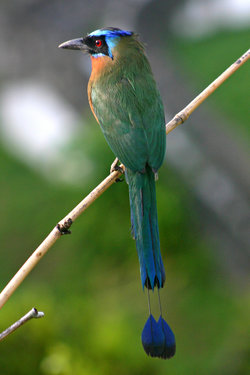- Motmot
-
Motmots 
Blue-crowned Motmot
Momotus momotaScientific classification Kingdom: Animalia Phylum: Chordata Class: Aves Order: Coraciiformes Family: Momotidae
GR Gray, 1840Genera Aspatha
Baryphthengus
Electron
Eumomota
Hylomanes
MomotusThe motmots or Momotidae are a family of birds in the near passerine order Coraciiformes, which also includes the kingfishers, bee-eaters and rollers. All extant motmots are restricted to woodland or forest in the Neotropics, and the largest diversity is in Middle America. They have a colourful plumage and a relatively heavy bill. All except the Tody Motmot have relatively long tails that in some species has a distinctive racket-like tip.
Contents
Behavior
Motmots eat small prey such as insects and lizards, and will also take fruit. In Costa Rica, motmots have been observed feeding on poison dart frogs.[1]
Like most of the Coraciiformes, motmots nest in tunnels in banks, laying about four white eggs. Some species form large colonies of up to 40 paired individuals. The eggs hatch after about 20 days, and the young leave the nest after another 30 days. Both parents care for the young.[2]
Motmots often move their tail back and forth in a wag-display that commonly draws attention to an otherwise hidden bird. Research indicates that motmots perform the wag-display when they detect predators (based on studies on Turquoise-browed Motmot) and that the display is likely to communicate that the motmot is aware of the predator and is prepared to escape.[3] This form of interspecific pursuit-deterrent signal provides a benefit to both the motmot and the predator: the display prevents the motmot from wasting time and energy fleeing, and the predator avoids a costly pursuit that is unlikely to result in capture.
There is also evidence that the male tail, which is slightly larger than the female tail, functions as a sexual signal in the Turquoise-browed Motmot.
In several species of motmots, the barbs near the ends of the two longest (central) tail feathers are weak and fall off due to abrasion with substrates, or fall off during preening, leaving a length of bare shaft, thus creating the racket shape of the tail.[2] It was however wrongly believed in the past that the motmot shaped its tail by plucking part of the feather web to leave the racket. This was based on inaccurate reports made by Charles William Beebe.[4] It has since been shown that these barbs are weakly attached and fall off due to abrasion with substrates and during routine preening. There are however also several species where the tail is "normal", these being the Tody Motmot, Blue-throated Motmot, Rufous-capped Motmot, and the Amazonian populations of the Rufous and Broad-billed Motmots.
Taxonomy
While the species-level taxonomy of most motmots has been relatively straight forward, it has been argued that the Blue-crowned Motmot should be split into multiple species, among these the Highland Motmot (Momotus aequatorialis).
Family Momotidae
- Genus Hylomanes
- Tody Motmot, Hylomanes momotula
- Genus Aspatha
- Blue-throated Motmot, Aspatha gularis
- Genus Momotus
- Russet-crowned Motmot, Momotus mexicanus
- Blue-crowned Motmot, Momotus momota
- Genus Baryphthengus
- Rufous Motmot, Baryphthengus martii
- Rufous-capped Motmot, Baryphthengus ruficapillus
- Genus Electron
- Keel-billed Motmot, Electron carinatum
- Broad-billed Motmot, Electron platyrhynchum
- Genus Eumomota
- Turquoise-browed Motmot, Eumomota superciliosa
A fossil genus of Oligocene coraciiform from Switzerland has been described as Protornis; it might be a primitive motmot or a more basal lineage. A partial momotid humerus found in early Hemphilian (Late Miocene, c.8 mya) deposits in Alachua County, USA has not been named; it might belong to an extant genus (Becker 1986).
-
Tody Motmot (Hylomanes momotula)
-
Rufous Motmot (Baryphthengus martii)
-
Turquoise-browed Motmot (Eumomota superciliosa)
-
Keel-billed Motmot (Electron carinatum)
Notes
- ^ Master, Terry L. (1999). Predation by Rufous Motmot on Black-and-Green Poison Dart Frog. Wilson Bull. 11 l(3):439-440
- ^ a b Forshaw, Joseph (1991). Forshaw, Joseph. ed. Encyclopaedia of Animals: Birds. London: Merehurst Press. pp. 143–144. ISBN 1-85391-186-0.
- ^ Murphy, Troy G. (2006). Predator-elicited visual signal: why the turquoise-browed motmot wag-displays its racketed tail. Behavioral Ecology 17:547-553.
- ^ Beebe, W. 1910. Racket formation in the tail-feathers of the motmots.1910 Zoologica, 1 (5): 140-149
"MotMotMotMotMot" is a phrase used on the UK's ITV2 show Celebrity Juice. Keith Lemon uses the phrase to describe the event of oral sex.
References
- Murphy, Troy G. (2007). Lack of melanized keratin and barbs that fall off: how the racketed tail of the turquoise-browed motmot Eumomota superciliosa is formed. Journal of Avian Biology 38:139-143.
- Murphy, Troy G. (2007). Racketed tail of the male and female turquoise-browed motmot: male but not female tail length correlates with pairing success, performance, and reproductive success. Behavioral Ecology and Sociobiology 61:911-918.
- Murphy, Troy G. (2007). Dishonest ‘preemptive’ pursuit-deterrent signal? Why the turquoise-browed motmot wags its tail before feeding nestlings. Animal Behaviour 73: 965-970.
- Becker, Jonathan J. (1986): A Fossil Motmot (Aves: Momotidae) from the Late Miocene of Florida. Condor 88(4): 478-482. doi:10.2307/1368274 PDF fulltext
External links
- Motmot Research, Troy G. Murphy
- Motmot videos on the Internet Bird Collection
Categories:- Momotidae
- Higher-level bird taxa restricted to the Neotropics
- Genus Hylomanes
Wikimedia Foundation. 2010.




